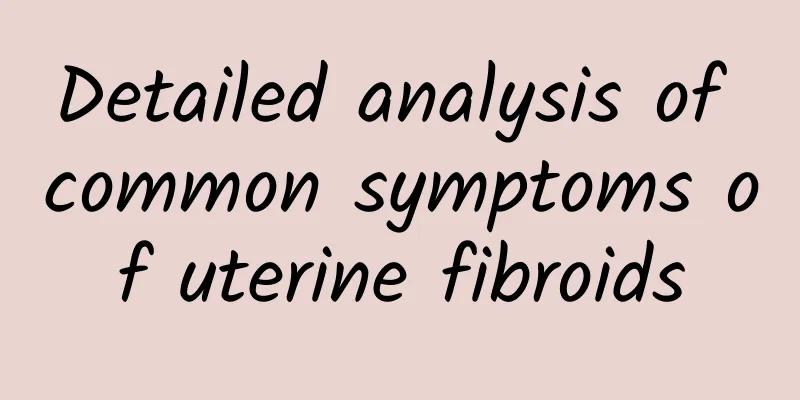Detailed analysis of common symptoms of uterine fibroids

|
Uterine fibroids are benign tumors that occur in the smooth muscle tissue of the uterus. If the fibroids grow rapidly in a short period of time or if the fibroids of postmenopausal women tend to grow, there is a risk that the fibroids will become cancerous. Therefore, it is very important to detect the symptoms of uterine fibroids in time and treat them as soon as possible. Below we invite experts to analyze the symptoms of uterine fibroids in detail. Common symptoms of uterine fibroids include: 1. Menstrual changes : The most common symptom of uterine fibroids, manifested as shortened menstrual cycle, increased menstrual flow, prolonged menstrual period, irregular vaginal bleeding, etc. 2. Increased leucorrhea : Increased leucorrhea, sometimes with a large amount of purulent and bloody discharge and necrotic tissue discharge with a foul odor. 3. Abdominal mass : Abdominal mass is also a common symptom of uterine fibroids. The abdomen is swollen, and a mass can be felt in the lower abdomen, accompanied by a feeling of falling. Generally, patients do not have abdominal pain, but often have lower abdominal distension, back pain, etc. When the pedicle of the subserosal fibroid is twisted, acute abdominal pain may occur. When the fibroid turns red, the abdominal pain is severe and accompanied by fever. 4. Compression symptoms : When the fibroid grows forward or backward, it can compress the bladder, urethra or rectum, causing frequent urination, dysuria, urinary retention or constipation. When the fibroid grows to both sides, it forms a broad ligament fibroid, which compresses the ureter and can cause hydroureteral or renal pelvis; if it compresses the pelvic blood vessels and lymphatic vessels, it can cause lower limb edema. 5. Secondary anemia : If the patient has excessive menstruation for a long time, it may lead to secondary anemia, with symptoms such as general fatigue, pale complexion, shortness of breath, and palpitations. 6. Infertility or miscarriage : Patients with uterine fibroids have the fibroid tissue in the uterine cornu compressing the entrance of the fallopian tube, causing the uterus to deform and hindering the implantation of the fertilized egg, ultimately leading to infertility. The above is the expert’s introduction to the symptoms of uterine fibroids. If you find the above symptoms, please seek timely treatment to avoid worsening of the condition and causing greater difficulties for future treatment. For more information, please visit the uterine fibroid disease special topic at http://www..com.cn/fuke/zgjl/ or consult an expert for free. The expert will then give a detailed answer based on the patient's specific situation. |
<<: Detailed explanation of the symptoms of vaginitis
>>: Key points for diagnosis of uterine fibroids
Recommend
How to differentiate functional uterine bleeding from systemic diseases?
Not long after Yuanyuan got married, her menstrua...
How dangerous is a Bartholin's gland cyst?
What are the hazards of Bartholin's gland cys...
Will threatened miscarriage occur during the second trimester? Will there be bleeding?
Treatment of threatened abortion requires prompt ...
A brief analysis of the harm caused by severe menstrual irregularity
Menstruation is a periodic vaginal discharge, whi...
The symptoms of cervical erosion are mainly divided into three degrees
Cervical erosion is the most common type of cervi...
How should women with mild cervical erosion regulate and care for mild cervical erosion? Five points to pay attention to
There are still many patients with cervical erosi...
Experts explain what are the symptoms of adnexitis
Many people know about the gynecological disease ...
Causes of Dysfunctional Uterine Bleeding During Menopause
Dysfunctional uterine bleeding, referred to as &q...
How to cure chronic pelvic peritonitis
Pelvic peritonitis is mainly divided into acute a...
Women must pay attention to the symptoms of irregular menstruation in time
Nowadays, more and more women are experiencing ir...
What is the B-ultrasound for adenomyosis?
What ultrasound should be done for adenomyosis? B...
Key points for daily care of patients with amenorrhea
If a woman experiences amenorrhea, she should not...
Clinical nursing of hyperprolactinemia
Hyperprolactinemia, also known as hyperprolactine...
What medicine is effective in treating Bartholinitis?
What are the treatment drugs for Bartholinitis? T...
How to care for patients with uterine effusion
Uterine effusion is a relatively serious gynecolo...









